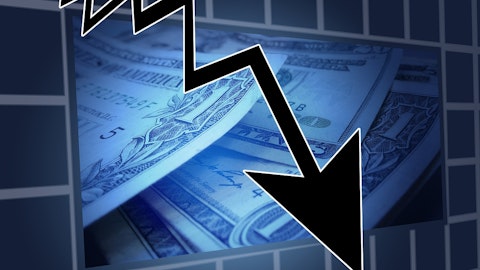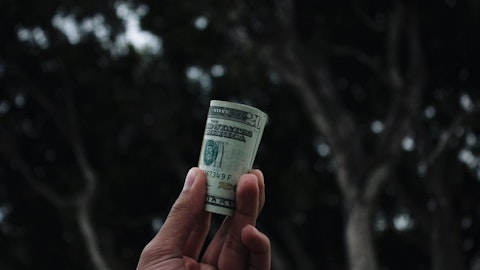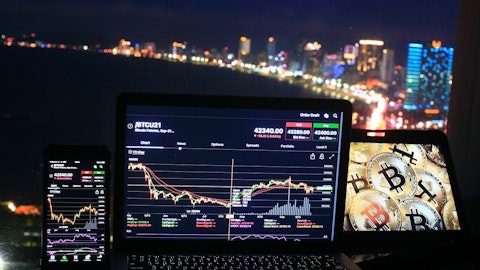Kinder Morgan, Inc. (NYSE:KMI) Q1 2023 Earnings Call Transcript April 19, 2023
Kinder Morgan, Inc. beats earnings expectations. Reported EPS is $0.3, expectations were $0.29.
Operator Welcome to the Quarterly Earnings Conference Call. At this time, all participants are in a listen-only mode. [Operator Instructions] Today’s call is being recorded. If you have any objections, you may disconnect at this time.I’ll now turn the call over to Mr. Rich Kinder, Executive Chairman of Kinder Morgan.Rich Kinder Thank you, Ted. And as usual, before we begin, I’d like to remind you that KMI’s earnings release today and this call include forward-looking statements within the meaning of the Private Securities Litigation Reform Act of 1995 and the Securities Exchange Act of 1934, as well as certain non-GAAP financial measures.Before making any investment decisions, we strongly encourage you to read our full disclosures on forward-looking statements and use of non-GAAP financial measures set forth at the end of our earnings release as well as review our latest filings with the SEC for important material assumptions, expectations, and risk factors that may cause actual results to differ materially from those anticipated and described in such forward-looking statements.Now today, Steve, Kim and David will take you through the details, but we believe 2023 is off to a good start while in a company our size, there are always lots of moving parts.
I think 2023 will be a solid year for KMI, and that with our capital expenditure program, we are positioning ourselves well for 2024 and beyond.At both the Board and management level, we remain committed to transparency and utilizing our strong cash flow to benefit our shareholders by maintaining a strong balance sheet, funding capital projects that produce returns well in excess of our cost of capital, paying a healthy and growing dividend, which by the way, in terms of yield, is one of the top 10 in the S&P 500 and repurchasing our shares on an opportunistic basis.In addition, through our investments in renewable natural gas, renewable diesel, and carbon capture and sequestration facilities, we are participating in the transition to cleaner energy.Let me conclude by reiterating our view, consistent with that of most energy experts worldwide, that fossil fuels will supply the great majority of the planet’s energy needs for decades to come.
For example, the recent IEA World Energy Outlook predicts that fossil fuels will supply 62% of the world’s energy demand in 2050. And just this week, our Assistant Secretary of Energy stated that given the current state of events and I quote, “the world absolutely needs new gas investment”.While we expect that renewables will experience rapid growth over the coming years, the demand for energy as a whole will also increase substantially. Thus driving the continued use of fossil fuels with natural gas playing an especially important role in the coming energy transition. In my judgment, this outlook deflates the argument of those investors who avoid our segment because they do not believe our assets will produce long-term value.And with that, I’ll turn it over to Steve.Steve Kean All right.
Thanks, Rich. I’ll make a few key points about our business, and then Kim and David will cover the substance and details of our performance, and then we’ll take your questions.The overview is this. Our balance sheet is strong. Our backlog of projects is up and our largest business, natural gas continues to show growing strength. A couple of more details on each of those. We built our budget for this year with balance sheet capacity available to enable opportunistic share repurchases and incremental investment opportunities at attractive returns, and we have done both.Second, the backlog projects are attractive returns in aggregate, well-above our cost of capital. At Investor Day, every year, starting with the 2015 to 2017 period, we have been showing you on an EBITDA multiple basis, how we perform in those investments relative to our original assumptions.

And we have performed very well. It’s currently a challenging time from a supply chain standpoint, but we expect to deliver the current slate of projects even with a challenge here and there at very attractive returns. Our current backlog is $3.7 billion, up $400 million quarter-to-quarter and had an aggregate EBITDA multiple of 3.5x.Third, on renewals, we showed at the beginning of the year how our base business renewals in the 2023 budget are showing more increases, the decreases especially in our natural gas business as the network tightens with increasing supply and demand. So a strong balance sheet, a growing backlog and good signs in our base business.A few other broad points about the macro backdrop underpinning this performance. First, as it’s becoming clear as time goes on and as Rich mentioned, hydrocarbon infrastructure is going to be needed for a very long time to come in its current use.
The world needs reliable and affordable energy to advance human development, and it needs natural gas transportation and storage assets to backstop renewables.Second, our assets are also well positioned for the energy forms of the future. You can see that with the renewable liquid fuels and renewable feedstocks products — projects in our products and terminals businesses.Third, our existing natural gas transportation and storage network is growing more valuable as the grid tightens with increasing demand over time, and increasing volatility. Compounding this effect is the difficulty of siting new infrastructure in many parts of the country.The value of the network was on display in the first quarter, where we had strong performance in our gas business and what was otherwise except for the West, a mild and unremarkable winter.Finally, on the other hand, our network is well positioned for expansion in those parts of the country where it is possible to build new infrastructure, the Gulf Coast primarily.
Our gas transportation and storage network is well positioned in Texas and Louisiana, where over 90% of natural gas demand growth is expected to take place. This point is well demonstrated by the growth in natural gas projects in our backlog.With that overview, I’ll turn it over to Kim.Kim Dang Okay. Thanks, Steve. So let’s start with the natural gas business unit as usual. Here, transport volumes increased by about 3% for the quarter versus the first quarter of 2022. That was driven by EPNG Line 2000 return to service in mid-February, a 10% increase in deliveries to power plants as a result of colder weather in the top left, coal retirement and low gas prices. The increases were offset by reduced LNG volume that was attributable to the Freeport outage, decreased export to Mexico and reduced HDDs in Texas, Midwest and the East.Natural gas gathering volumes were up 18% in the quarter compared to the first quarter of 2022, and that was driven by a 42% increase in Haynesville volumes, and a 21% increase in Eagle Ford volumes.Sequentially, total gathering volumes were up 4%.
In our products pipeline segment, refined products volumes were flat for the quarter versus the first quarter of 2022 that was roughly in line with EIA, although there’s some variability in the components.Road fuels were down 3%, but we saw a 12% increase in jet fuel as international travel increased. Crude and condensate volumes were down 5% in the quarter versus the first quarter of 2022 and that was driven by lower HH volumes as a result of unfavorable locational basis differentials coming out of the Bakken. Sequentially, volumes were up 1%.In our Terminals business segment, our liquids lease capacity remains high at 93%. Excluding tanks out of service for required inspection, approximately 96% of our capacity is leased.From a market perspective, there’s been some nice improvements in our major liquids markets.
In the New York Harbor, our Carteret Terminal is effectively 98% leased and had the strongest Q1 throughput since Q1 of 2019. In the Houston Ship Channel, we’re effectively 100% leased and rates have firmed up, and the Jones Act market continues to strengthen.On the bulk side, overall volumes were up 3%, and that was due to increased volumes in pet coke, coal, steel and grain. In the CO2 segment, prices were flat to down, depending on the commodity. On volumes, the CO2 volumes were down about 3%.With respect to oil volume, during the quarter, we had an outage at SACROC, which is our largest field and accounts for roughly two-thirds of our net production. The field was down completely for 10 days in late January, early February, and then it took another seven days to ramp up to full production, which impacted both our oil and NGL volumes.It’s hard to recreate what would have happened if we didn’t have the outage, but our very rough estimate is that overall net oil production would have been up 6% or better comparing to the first quarter — comparing the first quarter of 2023 to the first quarter of 2022 as opposed to being down 2%, and NGL volume would have been up 1% versus being down 22%.
These volumes would have added roughly $16 million or more to our segment results. Despite this outage, we still expect overall net oil volumes to be on budget for the year.And with that, I’ll turn it over to David Michels.David Michels Okay. Thank you, Kim. So for the first quarter of 2023, we’re declaring a dividend of $0.2825 per share, which is $1.13 per share annualized, up 2% from the 2022 dividend. I’ll start with a few highlights.We ended the first quarter of 2023 with net debt to adjusted EBITDA of 4.1 times, which leaves us with a good amount of capacity under our leverage target of around 4.5 times. We ended the quarter with over $400 million of cash on hand and nothing drawn on our $4 billion revolver capacity.We also issued $1.5 billion of bonds during the quarter, which addresses the majority of our funding needs for the rest of the year at favorable rates.
We repurchased 6.8 million shares at an average price of $16.62 per share, and we entered into additional short-term interest rate locks.We have now eliminated short-term interest rate exposure on about half of our floating rate debt through 2023. That helps protect us from further interest rate pressure and the locks have an average rate slightly better than our budget. Our balance sheet and liquidity are strong, and we continue to create value for our shareholders in multiple ways.For the full year, we are leaving our 2023 budget guidance in place. It’s still early in the year and a lot could change. We are facing pressure from commodity prices, as prices both realized to date as well as in the forward curves are below our budgeted prices.However, our forecast shows that pressure being substantially offset by better-than-expected operational performance, particularly in our natural gas and terminals business units.Before going on to the quarterly performance, you will notice that our financial disclosure has been updated.
We believe this updated disclosure is more aligned with recent SEC guidance, particularly related to non-GAAP disclosure. Now on to the quarterly performance, we generated revenue of $3.9 billion, which is down $405 million from the first quarter of 2022. Our cost of sales was down $679 million to $1.2 billion.As expected, interest expense was up versus 2022. We generated net income of $679 million, up 2% from the first quarter of last year. Adjusted earnings, which excludes certain items was $675 million, down 8% compared to the first quarter of 2022. On our business unit performance, our business segments were up 3% from the first quarter of 2022 in total, and our Natural Gas and Terminals segments were up and our products and CO2 segments were down.
Our Natural Gas segment was up with the largest drivers coming from greater sales margin on our Texas intrastate system and favorable rates on our recontracting at Midcontinent Express Pipeline.Our Product Pipeline segment was down mostly due to favorable first quarter 2022 commodity prices, which benefited our transmix businesses. Our Terminals segment was up mainly due to rate escalations and stronger volumes in our bulk terminals businesses, and our CO2 segment was down due to lower NGL prices and volume, lower oil volume and higher pipeline integrity costs.Our G&A and interest expenses were higher versus the first quarter of last year. And additionally, in the first quarter, we had sustaining capital higher versus last year. We budgeted to have higher sustaining capital for 2023 versus 2022.
And currently, we’re forecasting sustaining capital to be only slightly higher than budget for the full year.Well, we also had — but also some of the quarter over last year quarter variance is due to some spend being accelerated into the first quarter. So our adjusted EBITDA was $1.996 billion for the quarter, up 1% from last year. Our DCF was $1.374 billion, down 6% from last year, and our DCF per share was $0.61, down 5% from last year.Moving on to our balance sheet. We ended the first quarter with $30.900 billion of net debt, and our 4.1 times ratio is the same as it was at year-end 2022. Our net debt decreased $52 million over the quarter. And here is a high-level reconciliation of that change. We generated $1.333 billion of cash flow from operations.
We paid out $625 million approximately in dividends. We spent approximately $550 million in total capital, and that includes both growth and sustaining capital as well as contributions to our joint ventures, and we spent $113 million on stock repurchases. And that gets you close to the $52 million change for net debt.Finally, I’d like to remind our research analysts that we provide a quarterly breakdown of our annual budget on several metrics, EPS, EBITDA and DCF. And we do that since our expected yearly results are not evenly distributed. The main driver of that is our seasonality in our natural gas pipeline business, which typically generate greater margin on our first and fourth quarters due to strong winter demand resulting in higher rates and capacity utilization.Additionally, we have — we usually have greater expenses in the second quarter due to estimated tax payments.
So for example, we disclosed that our budgeted DCF for the first quarter was approximately $1.4 billion, while our budgeted DCF for the second quarter was approximately $1.0 billion reflecting that expected seasonality.Our actual DCF for the first quarter was $1.374 billion, a little lower than our budget, partially due to that accelerated capital — sustaining capital spending. And at this point, there are a number of analysts estimates that appear to be out of line with this quarterly guidance. So we encourage you to revisit that guidance as necessary.With that, I’ll turn it back to Steve.Steve Kean Okay. Ted, we’ll open it up to questions now. And I’ll just point out that in addition to the people you’ve heard from so far, we’ve got a good portion of our management team around the table here and we’ll try to make sure you get an opportunity to hear from them on the questions you have about their businesses.
So Ted, let’s open it up.
See also 35 Most Beautiful Places In The World and 8 Best Insider Trading Websites in 2023.
Question-and-Answer Session Operator [Operator Instructions]
First question in the queue is from Brian Reynolds with UBS. Your line is open.Brian Reynolds Hi, good afternoon, everyone. Maybe to start off on the EBITDA guidance. You talked about the base nat gas business perhaps outperforming slightly during the quarter, which is offset by the crude and nat gas deck and slightly lower product and terminals volumes. So I guess, perhaps on a forward-looking basis relative to the original guide in January, could you provide some puts and takes on a go-forward basis as the base nat gas business perhaps outperforms while the commodity deck and then product volumes relative to the January guide and PHP delay partially offset?
Thanks.David Michels Yes. I think that’s — I think the bottom line summary is commodity prices are pressuring our business in the CO2 business and a little bit in our natural gas business, and those are being largely offset with some of the items that you talked about largely offset so far for the year so that, that business operational performance — outperformance is offsetting that commodity price weakness and a lot of that is coming in our natural gas business, particularly in intra-states and in poles and higher commodity price, higher capacity sales values across our system in the natural gas business, we’re also seeing higher terminals, rate escalations than what we had budgeted.Brian Reynolds Great. Thanks. And maybe as a follow-up on growth CapEx, PHP delayed a few months, and then you have a TGP East 300 projects and the Tennessee Valley Authority projects coming into the backlog apparently.
Is there any upward pressure on CapEx this year, or could some of that get pushed into next? Thanks.Steve Kean Yes. Look, there’s some upward pressure on CapEx, but it’s not — I don’t think material to the overall investments that we’re making this year, Really what we’re seeing is there’s been a slight uptick in our capital expenditures — discretionary capital expenditures for the year, but that’s largely due to new opportunities that have emerged over the course of the year.And look, we’ve been managing this since we started seeing inflation crop up over the course of 2022. We continue to do that and continue to examine our assumptions. And when we sanction new projects, we’re always making sure that our cost and schedule estimates are up to date.
We’re monitoring on a routine basis, the lead times for various key components, et cetera. And — and overall, like I said in my remarks, I think we’re expecting to do very well on the capital that we’re putting to work.Brian Reynolds Great. Appreciate it. I’ll leave it there. Have a great rest of the evening.Operator Next question in the queue is from Jeremy Tonet with JPMorgan. Your line is open.Jeremy Tonet Hi, good afternoon.Steve Kean Good afternoon.Jeremy Tonet Just wanted to follow-up on the last point, I guess, as it relates to operational performance in the quarter versus budget noted that Texas interstate doing better than expected. Is that a function of just long-term contract renewals at better-than-expected rates, or was that kind of marketing opportunities that are spread based?
Just trying to get a bit more color on the drivers there and the durability of those trends.Steve Kean Yes, I mean, it’s really kind of across the board. It’s on contract renewals. It’s on short-term business that we’re doing, and it’s on rates that we’re getting for new business as well. Sital do you have any other comments there?Sital Mody I mean I really — and also improve storage values a big piece.Jeremy Tonet Got it, that’s very helpful there. And then just kind of shifting to the Permian as a whole. Natural gas egress, we’ve seen volatility in Waha prices and with PHP being pushed off a little bit here, I would imagine that would persist across the year. Just wondering your thoughts, I guess, for egress and when the next pipe of the Permian could be needed in Kinder could participate in that type of project.
Just wondering an updated Permian natural gas egress thoughts on their side?Steve Kean Yes. Well, of course, you’re right, and Waha has faced some pressure as a result, and there’s been a combination of just continued growth in production. Also, there’s been some maintenance, which used to be sort of back page gas daily kind of thing, but now it’s sort of front page of mainstream media.But there’s that, there’s the growth in the underlying business. And so we — clearly, we need additional expansion capability out of there. PHP provides that on a pretty quick basis. We are seeing a small delay, but that was fast capacity addition that we’re doing largely with compression and just a tiny bit of pipe out there.In terms of the longer term project egress, there are some on the boards right now, we continue to evaluate long-haul pipe expansion, but we’re not making any real commitments or updates on that.
We’ll continue to talk with customers. We believe it will be needed, but probably in the Sital to 20–.Sital Mody 2026, 2027.Steve Kean 2026, 2027 timeframe. So we’ll continue to work on it.Jeremy Tonet 2026, 2027 in service or when a new pipe would start construction?Steve Kean In service.Jeremy Tonet That’s very helpful. Thank you.Operator The next question in the queue is from Colton Bean with Tudor, Pickering, Holt. Your line is open.Colton Bean Good afternoon. Maybe just sticking on PHP, it looks like the one to two-month delay there versus initial expectations November 1st. So, is first, any detail on which components are driving the shift? And then are those now in hand, or do we still need to see some supply chain improvement to hit the December in service?Steve Kean Well, I don’t know about in hand.
So, this is our provider of the compression and they have upstream providers of certain — really, it’s electrical equipment. And they have that identified. They’re getting it, but it’s been delayed. And so that’s why we reflected a delay. We’re still going to get this thing done. It’s just — the supply chain is still a little bit tangled and that’s what we’re seeing there.Colton Bean Okay. So based on everything you’re seeing today, it still seems like sometime before year-end?Steve Kean Yes. Yes. Yes.Colton Bean Great. And then, David, you mentioned locking in roughly half the floating rate exposure through year end 2023. I guess can you comment on where that stands for 2024 and more generally, do you have interest in locking in rates for next year or contend to see how the market plays out for the time being?David Michels Yeah, it’s a good question.




